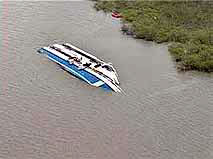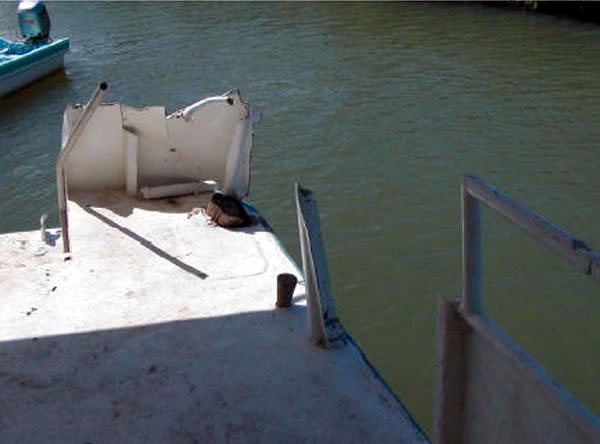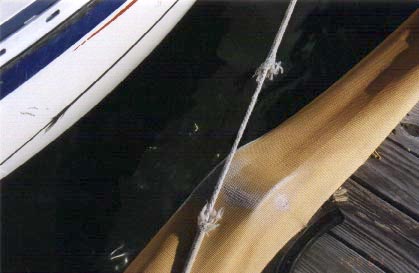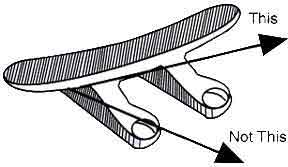

Admiral
Chester W. Nimitz
- If Peter Hughes Diving had a Hurricane Plan, it allowed for Wave Dancer to stay out at sea until well after a Hurricane Watch had been issued for Belize. BoatUS recommends mariners begin preparation for a Hurricane no later than when a Watch is issued.
- Because Peter Hughes Diving and Captain Martin kept the Wave Dancer out too long, when they did decide to head in to Big Creek Harbor they found the dock full. The delay in decision-making forced Wave Dancer to dock in a position that left her exposed to the hurricane's tidal surge.
- Captain Martin moored the boat with over 50 feet of the bow protruding into open water, exposed to current and, more critically, Iris' storm surge which was reported to be between 12-18 feet.
- While the crew of the boat did store dive gear and loose items below deck, the Bimini top was not removed, which added to the windage of the already top heavy profile of the Wave Dancer. This, in addition to the improper mooring arrangement caused Wave Dancer to act like a giant sail when Iris came ashore.
- Ground
tackle aboard the Wave Dancer was inadequate for tying up in
hurricane-force winds. The lines were frayed, of various widths and
materials, there was no chafe gear, and most were too short. Several
lines had to be tied together in
order to achieve the necessary length for mooring. The force of the
storm on the inferior gear caused Wave Dancer to break free at her
stern. Following that, the bow lines
tautened and broke. Wave Dancer rotated counter-clockwise, was blown
across the river, grounded, and rolled onto her port side. The interior
compartments of the Wave Dancer immediately flooded.

- Finally, passengers and crew remained aboard the boat during the hurricane. According to BoatUS:
This is one of the most
dangerous mistakes a
skipper can make. There is little, if anything, a skipper can do to
save a boat when winds are blowing 100 mph, tides are surging, and
visibility is only a few feet.

- A hurricane "warning" advisory is posted when sustained winds of 74 mph or higher are expected within 24 hours or less - too late, in most situations, to head for the boat. Securing the house, gathering emergency provisions, and evacuating the family will need attention at this point.
- A hurricane "watch" is posted when hurricane conditions pose a threat to a specified coastal area, usually within 36 hours. Some hurricane observers believe waiting for a watch to be posted also may be too late to head for the marina or to move the boat to a safer location.
- The best advice is to prepare or move your boat when a hurricane is a substantial possibility, even before a watch is issued. If you wait longer, and your plan includes relocating the boat, bridges may be locked down and the hurricane hole you chose may be inaccessible. Or, if you planned to have your boat weather the storm ashore, you may find the marina is too busy to haul your boat.
***
 Boats are especially vulnerable to a storm's winds and
surging seas. Some are slammed into their docks by high water, or
flooded and sunk by rain. Others roll and thrust violently against
mooring lines until they chafe through the lines and wind up broken on
the rocks.
Boats are especially vulnerable to a storm's winds and
surging seas. Some are slammed into their docks by high water, or
flooded and sunk by rain. Others roll and thrust violently against
mooring lines until they chafe through the lines and wind up broken on
the rocks.
- Planning where your boat will best survive a storm, and what protective steps you need to take when a hurricane threatens, should begin months before hurricane season.
- Any boat in the water should be secured in a snug harbor. The trick is deciding which harbors will still be snug if a hurricane comes ashore and which will be vulnerable.
- Storm surge - high water - is a major consideration. A storm surge of 10¹ or more is common in a hurricane, so a seawall or sandy spit that normally protects a harbor may not offer any protection in a hurricane.
- Crowded, rock strewn harbors are picturesque, but they may not be the best place to keep your boat in a storm. Rocks are hard on boats, should yours break loose, and in a crowded harbor the chance of another boat breaking loose and banging into your boat is that much greater.
- <>Many boats have cleats and chocks that are woefully
inadequate. This problem becomes critical when more and larger diameter
storm lines are used during a storm. If necessary, add more and larger
cleats and chocks now; they'll make securing the boat easier all year.

- Asses the ability of cleats to carry heavy loads. This means making sure all are backed properly with stainless steel or aluminum plates. Marine plywood is OK if it's healthy-free of rot and delamination.
- Don't put too many eggs in one basket by leading numerous lines to a single cleat, even if it is backed properly. Two lines per cleat is probably the maximum. Also, a cleat is not reliable when lines are led perpendicular to the base and the cleat can be wrenched out by the tremendous loads.
- Lines led perpendicular from a cleat can wrench the cleat out of the deck. Two-hole cleats are more vulnerable than four-hole cleats.
- One of the first steps when preparing your boat for a storm is to take off all loose gear that will create windage: canvas covers, bimini tops, spray dodgers, outriggers, antennas, anchors, running rigging, booms, life rings, dinghies, portable davits, etc.
***

One of the most dangerous mistakes a skipper can make is to stay aboard his or her boat during a hurricane. Several accounts given in claim files indicate that there is little, if anything, a skipper can do to save a boat when winds are blowing 100 mph, tides are surging, and visibility is only a few feet.
What can happen? Consider the case of a 68-year old skipper in Charleston, who together with his grown nephew, took their trawler up the Wando River to ride out Hurricane Hugo in what they thought would be a sheltered hurricane hole. He reported that the boat seemed to be doing fairly well, but later that night the wind picked up to over 100 mph and 15' seas sent the boat crashing completely over.
The two men were trapped briefly in a pocket of air underwater when another wave rolled the boat back upright. The two men scrambled onto the deck and were eventually rescued, but not before almost drowning and being overcome by exposure.
Another skipper who stayed aboard his motorsailor at a marina during Gloria had to jump overboard and swim through breaking waves, drifting boats and debris after another boat broke free and rammed its mast (the boat was on its beam ends) through his boat's pilot house window. Again, he was lucky to reach shore alive. Two Miami men who stayed aboard a Sportfisherman (not insured by BoatU.S.) during Andrew were not so lucky. Both drowned while trying to escape their sinking boat.
When a hurricane is approaching, you should certainly do everything you can to protect your boat: secure extra lines, set out anchors, add chafe protection, strip the boat above and below decks, etc. Do whatever you think it takes, then head inland. Your boat can be replaced; you can't.
Sources:
BoatUS
IMMARBE Report
Dave DeBarger, Survivor
Hurricane Warning: A guide to Preparing Boats and Marinas for Hurricanes BoatUS
Hurricane Tracking Chart BoatUS



All
contents of this site © 2005 Milly Armao, except where
otherwise noted.